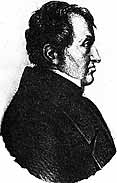![]()
![]()
 Almost immediately after Hans Christian Oersted in Copenhagen Denmark proposed that electric current causes an effect on a magnetic compass which circulates around the wire, André-Marie Ampère (1775-1836 shown at left) in Paris read about Oersted's claimed discovery, investigated, and exactly one week after receiving news of Oersted's discovery showed at the September 18th meeting of the Academy that two parallel wires carrying electric currents magnetically attract each other if the currents are in the same direction and repel if the currents are in opposite directions. Nearly two and a half centuries after William Gilbert suggested that electric and magnetic effects were distinct and should be studied independently (resulting in much being learned about both), Oersted and Ampère propose not only a connection, but that magnetic effects require electric causes (which strangely also resulted in much being learned about both).
Almost immediately after Hans Christian Oersted in Copenhagen Denmark proposed that electric current causes an effect on a magnetic compass which circulates around the wire, André-Marie Ampère (1775-1836 shown at left) in Paris read about Oersted's claimed discovery, investigated, and exactly one week after receiving news of Oersted's discovery showed at the September 18th meeting of the Academy that two parallel wires carrying electric currents magnetically attract each other if the currents are in the same direction and repel if the currents are in opposite directions. Nearly two and a half centuries after William Gilbert suggested that electric and magnetic effects were distinct and should be studied independently (resulting in much being learned about both), Oersted and Ampère propose not only a connection, but that magnetic effects require electric causes (which strangely also resulted in much being learned about both).
You probably have used a balance many times to measure mass by comparing the gravitational force on an unknown with the combined gravitational forces on a set of standard masses. In Experiment IV-6 we used a spring balance to measure electric forces. But balances can also be designed to compare known gravitational forces with unknown electrical and magnetic forces. Whereas gravity seems to always provide attractive forces, electrical and magnetic forces can cause both attractive and repulsive forces. So electric and magnetic balances should be designed to detect and measure both.
In this experiment wires are suspended at each end from above so they can freely swing from side to side. There is an adjustable counter weight above the support. If the counter weight is set low, there will be considerable gravitational restoring force (like a swing; see Experiment I-5) which will make the balance less sensitive to small forces. If the counter weight is set too high, the balance will be unstable, top heavy, and flip over. If the counter weight exactly balances the mass below, the balance will rotate and be unable to indicate when the opposing forces are equal. So the counter weight should be set just below the exact balance point so that the balance will swing back and forth very slowly, but be sensitive to very small differences in the forces.
This balance is constructed with a low mass arm extending horizontally to hold standard masses which will be known lengths of very fine wire. The standard masses will be hung at a distance from the fulcrum equal the distances the electrical wire is below the fulcrum. That way the gravitation and electrical forces will have equal leverage (F1 x l1 = F2 x l2) so when balanced, the size of the electrical force will equal that of the gravitational force which we can calculate. The balance is adjusted to zero
when it holds no standard mass and no current flows in the wires. Then a known length of wire (thus known mass) is placed on the balance, and electric current is adjusted to flow steadily thought the wire causing a force exactly opposing the gravitational force of the standard mass.
Today scientists often need to use equipment beyond their personal ability to build or purchase. Research institutions around the world used government and other grant monies to build such equipment. The institutions either host scientists selected to perform proposed experiments, or the institution support staff conducts the proposed experiment and supplies the results to the scientists who proposed the research. We shall follow the latter mode of research for this experiment.
Procedure:
| length of wire (cm) | Gravitational Force = Electrical Force (Newtons) |
Electric Current (Amperes) |
| 2 | 0.6 | |
| 6 | 1.7 | |
| 8 | 2.3 | |
| 10 | 2.9 | |
| 12 | 3.3 | |
| 14 | 3.9 | |
| 16 | 4.5 | |
| 18 | 5.1 | |
| 20 | 5.6? |
This experiment is now days reversed! Electric current is adjusted in two parallel wires of length one meter spaced one meter apart. The current necessary to create one newton of force is DEFINED to be one Ampere.
The amount of electric charge flowing past any point in the wire carrying one Ampere is defined to be one Coulomb.
| separation distance (cm) |
1 / d (cm-1) |
length of #30 wire (cm) |
Electrical Force (Newtons) |
| 0.6 | 20.0 | ||
| 0.9 | 15.5 | ||
| 1.2 | 11.5 | ||
| 1.65 | 9.0 | ||
| 2.15 | 7.0 | ||
| 2.75 | 5.5 | ||
| 3.25 | 5.0 | ||
| 3.8 | 4.5 | ||
| 4.7 | 4.0 | ||
| 6.25 | 2.5 |
Finally, record your procedures, measurements, and findings in your journal. If you need course credit, use your observations recorded in your journal to construct a formal report